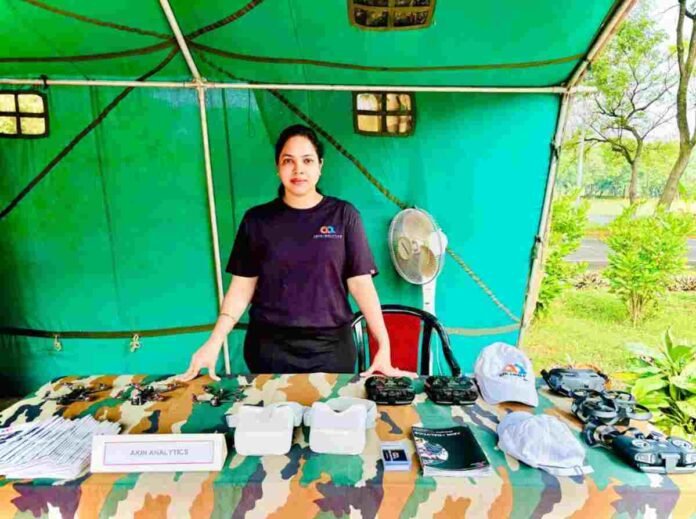World Entrepreneurs’ Day Exclusive Interview
Q1. On World Entrepreneurs’ Day, how has India’s startup ecosystem influenced your journey?
India’s deep-tech space is finally being taken seriously. Government initiatives like Aatmanirbhar Bharat, Make in India, Digital India, and Industry 4.0 have transformed the environment for innovation. I’ve had the opportunity to be part of initiatives like DST’s SISFS, MeitY SAMRIDH 2.0, and Nidhi Prayas at KIET, all of which provided us with not just funding but access to mentorship, policy support, and strategic networks. That foundation helped us move fast in a precision-focused industry.
Q2. What is Akin Analytics doing differently in the drone space?
Most players focus on drone flying. Our focus is on the data — converting raw aerial footage into decision-ready intelligence. We deliver real-time insights for mining, infrastructure, agriculture, and energy sectors. Whether it’s calculating mine volumes, detecting road cracks, assessing solar panel health, or forecasting crop yields, our AI platform transforms data into clear, usable intelligence that saves time, money, and sometimes even lives.
Q3. Is your technology scalable across global markets?
Absolutely. The problems we’re solving aren’t unique to India. Unsafe mines in Australia, inefficient solar inspection in the Middle East, or poor road maintenance in Southeast Asia — our AI is built to adapt across geographies and deliver outcomes that are relevant, reliable, and fast.
Q4. How are investors reacting to your sector?
They’re cautious, but the tide is turning. Deep-tech is high-capex and long-gestation, so it requires founders who understand the domain inside out. My experience in industrial operations and government projects, backed by academic grounding in business analytics and an MBA from ISB, gives us credibility. We don’t just build tech. We solve sector-specific problems with execution focus.
Q5. Why did you choose a sector as tough as AI-driven drones?
Because it’s meaningful. Traditional sectors like mining, infrastructure, and agriculture are still using outdated and unsafe methods. We’re not just building a product. We’re modernizing entire industries, making them safer and more transparent. If we want real change, we have to be willing to solve the hard problems.
Q6. What does your team look like, and how do you align with national programs like Namo Drone Didi?
We’re a 25-member team that includes drone designers, AI/ML engineers, GIS experts, and DGCA-certified trainers. We are actively contributing to Namo Drone Didi by training women drone pilots and are also developing our own drone hardware and AI models to reduce dependency on imports, aligned with Make in India and India’s semiconductor mission.
Q7. What makes your AI platform a game-changer?
The drone is just a data collection tool. The real power is in the platform. Ours analyzes large volumes of spatial data and delivers field-level insights. My background in field operations and data science allowed me to build a product that connects the dots between raw data and boardroom decisions.
Q8. How do you navigate India’s regulatory landscape for drones?
We stay proactive. Akin has its own DGCA-approved RPTO, which gives us operational independence and brand credibility. We also maintain constant dialogue with regulators to ensure our roadmap is compliant and future-aligned.
Q9. In a competitive sector, how do you keep Akin’s original vision intact?
By keeping the founder’s compass at the center. Investors and stakeholders are enablers, but the mission is non-negotiable. We’ve never chased trends. We’ve chased impact.
Q10. Why set up your Centre of Excellence in a tier-2 city instead of a metro?
Because that’s where the technology is needed the most. Farmers and rural youth are the end users of drone services in agri-tech and infrastructure. Being close to them helps us co-create, test, and improve rapidly, whether it’s precision spraying, field monitoring, or training new drone entrepreneurs.
Q11. Is the Centre of Excellence commercially viable?
Yes, and it’s socially impactful from day one. I’ve seen farmers carrying pesticide tanks, exposed to chemicals and snakes. Our drone services remove that risk and bring efficiency. Revenue will grow over time, but the health and safety benefits are immediate.
Q12. How important is indigenisation to your business model?
It’s central. We’re developing our own flight controller, AI models, and drone frames. Depending on imports is a strategic risk, especially for critical sectors. Our goal is to make India a net exporter of drone tech.
Q13. How do you manage the high capex and long sales cycles?
By being smart about it — phased investments, using government grants, and building partnerships that reduce upfront cost. Government and industrial clients take time to convert, so we focus on education, ROI demonstrations, and building long-term trust.
Q14. How do you convince clients to adopt drone and AI solutions?
By showing results. Live demos, sector-specific case studies, and POCs help clients see value clearly. When you show that what took three weeks can now be done in three hours, the switch becomes obvious.
Q15. What’s your message to young entrepreneurs, especially women in tech?
Learn your domain inside out. Resilience and domain expertise will outlast funding cycles and market trends. Women in tech face tougher odds, but the impact we can make is unmatched.
FOR MORE INFORMATION
https://www.akinanalytics.com


